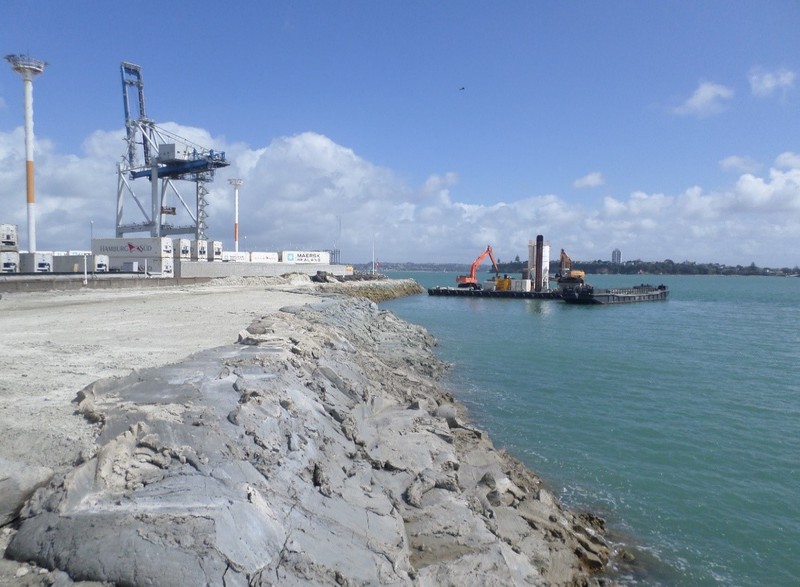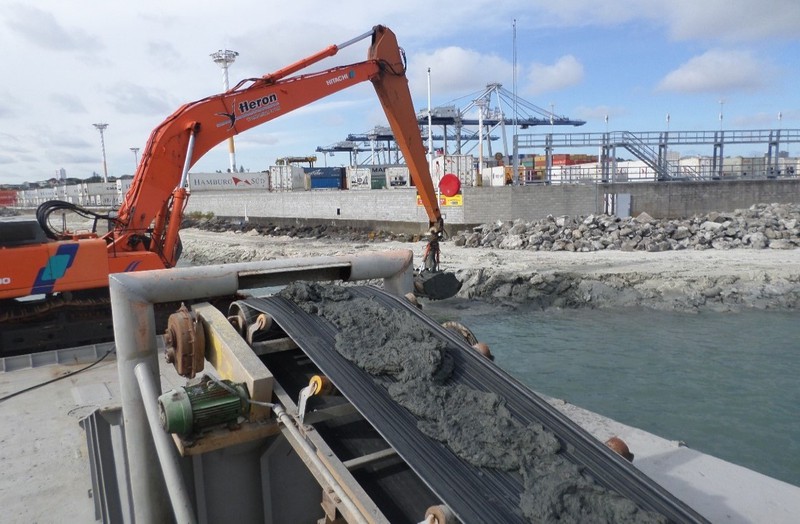Use in expansion of port terminal
Regular maintenance dredging were carried out in the Port of Aucklnad in the Rangitoto channel and port berthing pockets (POAL, 2018). The material dredged is beneficially reused in the expansion of the port’s container terminal. In the early 2000’s the Port of Auckland began stabilising the dredged material with Portland Cement to produce mudcrete (POAL, 2018). The dredged material was excavated from the seabed using Heron Construction Co. Ltd’s backhoe dredging barges (Machiavelli, Kimahia & Combi) and transported via hopper barges to a reclamation site (HeronConstruction, 2015). The hopper barge was then attached to Heron Construction Co. Ltd’s Mesenge pugmill barge. The purpose built Mesenge pugmill barge stabilised the dredged material and placed the mudcrete in the port’s reclamation using a Hitachi EX700 longreach excavator.
The stabilisation of sediment with Portland Cement ensures that the dredged material binds quickly to form mudcrete, limiting the leaching of most of the contaminants into the harbour (Priestley, 1995). Regular monitoring and inspection conducted by the Ports of Auckland confirm that the process has minimal impact on the quality of water (POAL, 2018). The beneficial reuse of dredged sediments in the reclamation project had also provided an alternative to disposal of sediments at sea, eliminating potential impacts on the environment which are associated with the resuspension of sediments in the water column. The use of dredged material in the reclamation lead to a reduction in carbon footprint, mainly due to minimized tug boat movements and the eradication of trucks delivering quarried material for fill in the reclamation. The use of dredged material in the reclamation, as opposed to quarry fill, resulted in the elimination of 160,000 truck movements throughout Auckland.
The beneficial use of mudcrete on the Ports of Auckland’s container terminal expansion resulted in cost savings (POAL, 2018). The cost saving was realised due to early dredged material management planning, resulting in efficient logistics, eliminating the need for hopper barges and tugs to travel great distances for the disposal of dredged materials. The use of mudcrete was more economical when compared to quarry aggregates, which has greater value when utlised in roads and concrete projects.
Graphical information:


References/web links
- http://www.poal.co.nz/sustainability/environmental-management/dredging [Accessed 14/02/2018] (POAL, 2018).
- https://www.heronconstruction.co.nz/ [Accessed 14/02/2018] (HeronConstruction, 2015).
- Priestley, S.J., 1995, “Beneficial Use of Mudcrete In Reclamations”, Transactions on the Built Environment volume 8 (Priestley, 1995).